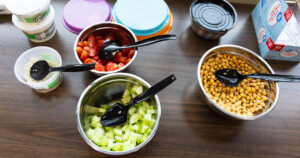
September is Childhood Obesity Awareness Month!
Childhood obesity is a sensitive issue to discuss with children and teenagers. It is important that we use positive and appropriate wording when talking to any person who is overweight, but this is especially true for this age group. Weight bias can start affecting individuals at a very young age and this has the potential to negatively impact their mental health, including self-esteem and body image.
Choose Your Words Wisely
Using positive language when discussing nutritional habits and choices with kids is important! Talk about what we ARE doing and ARE eating instead of saying “no” and focusing on restricting. It is more helpful to talk about the good things that the choices you are making are doing for you and your body. For example, getting the right mindset for a child to eat more fruits and vegetables might be phrased as:
Hey, doesn’t this fruit taste great for dessert after supper? And it gives your body good energy to use!
You can have as many seconds on vegetables and chicken as you want.

These examples highlight the idea of not calling food “good” or “bad”, but instead convey the idea that healthier foods are “green light” or “all-the-time foods”, whereas other foods in moderation, perhaps that dessert treat, are “sometimes foods” or quite simply, “treat foods”. Essentially, let children know that all foods have a place in a healthy diet, that there are no “bad” foods or “good” foods. Here are some other examples when addressing those treat foods and cautioning moderation without making a child (or yourself) feel negative about this choice:
Cake is a food we use to celebrate special things in life, that’s why we save it for special days.
This is helpful because we’re showing a relationship between enjoying cake with a special, happy occasion while indicating that it’s not necessarily something to be eaten every day.
Cake is a bad food because it has a lot of sugar and calories, so don’t eat that!
Aside from the obvious use of the word “bad”, the connotation here is negative because one is made to feel like something sweet and with a high caloric value can never be enjoyed! Restricting this food entirely might ultimately backfire in creating unhealthy habits, perhaps if one doesn’t learn moderation while enjoying sweets!
The Art of Making Decisions

Many of us may not have been consciously taught to think about how full we were when eating as a child and later found it necessary question to ourselves as adults. Also, if we weren’t involved in some of the decision making with food, how did we learn such things heading into adulthood? Here are some tips about specific, but simple decisions that kids can help make when it comes to having a good relationship with food.
Ask children to check into their own fullness cues to know when to stop eating:
Helpful: Does your belly say you are full yet?
Less helpful: You have to finish your plate before you leave the table.
We know the latter comment was once standard for many generations who were taught not to waste food (a nutrition topic for another time), but this belief often teaches us that finishing our plate, even when full, is more important than how extra calories will ultimately affect our bodies and our well-being. Teach healthy boundaries for foods that are best chosen in moderation. For example:
Sweets are okay to have a couple of times per week, so let’s enjoy ice cream on Friday nights together.
Here, we’re not eliminating a food, but rather assigning it a special occasion (like the cake example above). Instead, ice cream gives us another reason to say: “TGIF and to enjoy time with family or socially” — a boost to our emotional health as well!
Provide children with 2 or 3 healthy options to pick from for meals and for snacks to help them feel in charge of their decisions. For example:
Would you like carrots, broccoli, or applesauce with your chicken sandwich?
Should we make meatloaf and mashed potatoes tonight or chicken tenders and peas?
The following suggestions may seem not immediately impactful, but they also help to allow children and teens to be involved in making choices: allow them to assist with grocery shopping, food preparation (as age appropriate), setting the table, etc. These ideas reinforce decision-making with food choices and the positive feeling of being a productive and helpful member of the family, all while fostering a positive connection to food as well as time spent with family!
What About Snacks and Beverages?

You may be surprised to learn that both children and adults may misinterpret thirst as hunger. Do your nutritional choices include a daily intake of water and foods to provide hydration? If your child or teen asks for snacks shortly after eating full meals, offer calorie-free beverages and redirect them to other activities. Also, children may have more difficulty identifying and expressing emotional needs or boredom, and may interpret this as hunger. If they continue asking for snacks despite being distracted and comforted, then provide a healthy but appropriate snack, like fruits, whole grain crackers, cheese stick, ¼ cup trail mix, veggies and dip, or a yogurt cup.
Exercise or Active Play?

Exercise is another aspect of nutrition and one for which adults should learn and demonstrate healthy habits. Making time for physical activities and trying new things can be even more fun and rewarding when kids are involved, so why not call it, “active play”?
If you have a yard, use it! Play tag, hop-scotch, hide and go seek, hula hoop, jump rope, shoot hoops, kick a soccer ball, toss a baseball around, etc. You can also utilize local playgrounds and parks, check out a hiking/biking trail, try swim lessons, or try a new sport. Whatever activity it is, encourage it and participate in it! Look for options that your child enjoys.
Also, if outdoor activities in colder weather aren’t idea, consider indoor options for winter. Some suggestions include small indoor door-hanging basketball hoop, listening to music and dancing in the kitchen, the use of game systems like Wii Fit or Sports, Nintendo Switch Sports, Beat Saber virtual reality, etc. Some outdoor options could also double as indoor options depending on space at home.
Body Image and Acceptance
The self-deprecating comments about our own bodies are noticed by children whether or not we realize it, which is why taking care of ourselves to reflect the importance of positive language and working on developing healthy habits is so important for adults and children. Frame conversations about bodies around the function of different parts and health opportunities as opposed to weight and appearance.
Helpful: Some people who are heavier have more health problems so let’s work on making healthy food choices that help your body work its best.
This statement conveys a collective initiative and trying to be healthier overall, versus the following statement:
You need to lose weight so that you look nice and thin like the other kids.
(Ouch!) This is not helpful and quite frankly is rather potentially harmful to mental and emotional well-being. Every body is different, and each of us has different nutritional needs, although the fundamentals remain the same. It’s often not beneficial to compare ourselves or someone else to others, and what is considered “thin” is perhaps not even healthy from one person to the next.

Parents, your kids are listening, and you are not helping yourselves when calling yourself “bad” or “fat”, or saying: “I need to go on a diet”. Flip the script and use positivity and motivation for your own image. Try to say things like:
Mommy hasn’t been feeling very good so she’s going to try to eat some healthier foods to feel better.
All this exercise we are doing is going to help you do really well in football (or insert sport/gym class here)! Your heart and lungs are going to be SO strong!
Summary
Notice this wellness tip did not mention trying to get your child to lose weight or to follow a specific diet that excludes certain foods altogether, like sweets. Remember, its all about moderation, not outright restriction that is important to our mindsets! If a child’s current weight or body mass is truly an issue, let that decision be made by a pediatrician or family medicine physician who can monitor and continue to provide guidance.
Research shows that the younger a person is when they start building a healthy lifestyle, the more likely they are to follow through with it in adulthood. What we are seeing is that habits are much more challenging to change once someone hits adulthood. Also, the more support they have the better! Kids are typically not going to make lifestyle choices independently, they require reinforcement from their parents in order to follow through with it. Normalize healthy habits within the entire family so that no one feels left out or different. Remember: be a role model with healthy habits, such as trying new foods and speaking positively about your body.


